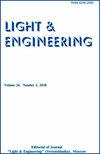A Retrospective of Artificial Lighting from Ancient Times to the Present Day
IF 0.3
4区 工程技术
Q4 ENGINEERING, ELECTRICAL & ELECTRONIC
引用次数: 0
Abstract
A retrospective of the origin and development of light sources is given depending on the history of human development and the creation of fundamental sciences: mathematics, physics, and electrical engineering. Four stages of development and creation of artificial light sources in buildings and structures are proposed. A detailed description of the pre-electric period (regular use of fire by the man; the Bronze Age, the middle Ages and modernity) is presented. The second period begins with the opening of the voltaic arc, which can be called the beginning of the electric period. Illustrations of each discovery with lighting of rooms and buildings of the corresponding period are presented. The period of inventions, which led to the beginning of the third, gas lighting period, is described. This period includes, among other things, the combined use of gas lighting devices with electric lighting and combined gas-electric lighting. The fourth period begins at the beginning of the third millennium and continues to the present. During this period new alternative lighting sources appear along with incandescent lamps and gas-electric sources. Lighting engineering is becoming an independent branch of science and is being studied in all universities of our country, which increases the rate of appearance of new inventions and types of calculation. There are such lighting sources as fluorescent and LED lamps and fixtures. At the end of the article, the opinions of scientists on the prospects for the development of artificial lighting according to various criteria are presented. The article is provided with a large number of illustrations for all stages of development.古今人工照明回顾
回顾了光源的起源和发展,根据人类发展的历史和基础科学的创造:数学,物理和电气工程。提出了在建筑物和构筑物中开发和创造人工光源的四个阶段。对前电时代的详细描述(人类经常使用火;(青铜时代,中世纪和现代)。第二个时期以伏打电弧的开启为开端,可称为通电时期的开端。每个发现的插图都附有相应时期的房间和建筑物的照明。发明的时期,导致了第三,气体照明时期的开始,描述。除其他外,这一时期包括燃气照明装置与电力照明和燃气-电力联合照明的结合使用。第四个时期开始于第三个千年之初,一直持续到现在。在此期间,除了白炽灯和气电光源外,还出现了新的替代照明光源。照明工程正在成为一门独立的科学分支,在我国的所有大学都在学习,这增加了新发明和新计算类型出现的速度。有荧光灯和LED灯和灯具等照明光源。在文章的最后,根据各种标准提出了科学家对人工照明发展前景的看法。文章提供了大量的插图,为所有的发展阶段。
本文章由计算机程序翻译,如有差异,请以英文原文为准。
求助全文
约1分钟内获得全文
求助全文
来源期刊

Light & Engineering
ENGINEERING, ELECTRICAL & ELECTRONIC-OPTICS
CiteScore
1.00
自引率
50.00%
发文量
0
审稿时长
1 months
期刊介绍:
Our magazine
develops comprehensive communication within the lighting community, providing opportunities for discussion and free expression of opinions of specialists of different profiles;
contributes to the convergence of science and engineering practice, the search for opportunities for the application of research results in lighting and technological applications of light;
keeps the scientific community up to date with the latest advances in the theory of the light field, providing readers with operational professional information;
initiates international cooperation, promotes and distributes the results of Russian authors in the international professional community;
provides equal opportunities for authors from different regions of Russia and other countries.
The journal publishes articles in the following areas:
visual and non-visual effects of radiation on humans;
light field theory;
photometry and colorimetry;
sources of light;
ballasts;
light devices, their design and production technology;
lighting and irradiation installation;
light signaling;
methods of mathematical modeling of light devices and installations;
problems of energy saving in lighting, installation and operation of lighting installations;
modern production technologies of lighting products for lighting control systems;
innovative design solutions;
innovations in lighting and lighting design;
the study of the effect on plants and animals, problems of using light in medicine;
problems of disinfection of premises, water and smell elimination with the help of technology of UV radiation using;
problems of light in the ocean and space.
 求助内容:
求助内容: 应助结果提醒方式:
应助结果提醒方式:


